Circus Culture is alive and well. Young creatives have taken to learning the trades of the sideshow as well as the entertainments of the center ring. Acrobats and rope climbers entertain in trendy neighborhoods and people enroll in clown college with all earnestness. But what of a musician enamored by the sounds of the circus? Where can you hear the real thing when the mainstream troops have turned to canned sound for their accompaniment and the avant-garde favor Eastern European phantasmagoria? (Even if it is kind of awesome.)
Fortunately, a select society of amateur enthusiasts has been researching and rehearsing the real thing for decades. The beauty of America is that, even before the internet, you could always find people to share and encourage your marvelous obsessions.
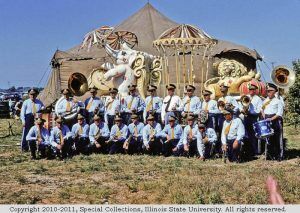
In 1971 Charles Bennett Jr. and Art Stensvad gathered fans of circus music into Windjammers Unlimited and the organization is still going strong today. Membership holds steady at over 500 members and they produce a bi-monthly newsletter, The Circus Fanfare, to share goings on and new discoveries in the genre. They also meet every summer to practice, record and perform the music together, and every winter to play for an actual circus at their annual convention. According to their website “Circus musicians are traditionally called ‘windjammers’ because they ‘jam wind into cornets, clarinets, trombones, baritones, etc. for six to seven hours a day'”. If that sounds like fun to you, here’s your chance.
Why Circus music? And why in these Syncopated Times? To further quote from the Circus Music History page on the Windjammers website:
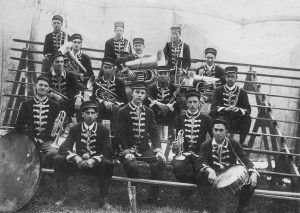
“The most often-played circus music is the march, but there are plenty of opportunities for waltzes, rags, serenades, intermezzos, Latin rhythms, smears and galops. Different styles of music characterize each act. Wild animals may be accompanied by fierce marches with a driving beat like “Bravura,” or “Burma Patrol.” Waltzes like “Over the Waves” and “Wedding of the Winds” might lull us through graceful trapeze performances. The pacing for a big slapstick clown act might be set by a galop like “Prestissimo,” or “The Homestretch.” Galop, incidentally, is the French spelling for the horse’s gallop, which suggests both the source and the exhausting two-beat pace of the music.”
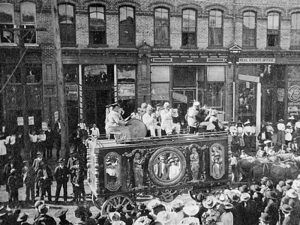
That is, circus music is no one thing, but can be a soundtrack to all kinds of performances. Gaining the musical chops to accompany other goings on is nothing to sneeze at, Count Basie got his start as a movie theater organist.
The golden age of composition expressly intended for circus bands also coincided with the ragtime era. All that catchy syncopation has lodged in the public imagination and continues to woo both nostalgists and circus punks today. We may scoff at someone saying a lively early jazz number sounds like “Circus Music” but they aren’t that far off, they just lack the familiarity necessary for discernment.
Circus bands as we understand them now originated in the mid 19th century. Earlier bands had involved strings but as crowds became bigger, and tents larger, the ability to be heard required the takeover of brass bands. In the latter part of the century, reed instruments were adopted, the compositions became more complex, and the bands under a few leaders became well known.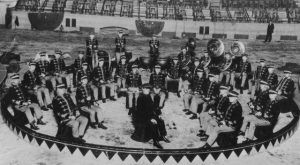
As the 20th century dawned a series of composer-bandleaders wrote most of the tunes we instantly associate with the circus today… and some others worth discovering. Merle Evans led the Ringling Brothers and Barnum & Bailey Circus band from 1919-1969 and joined the Windjammers as a living legend among circus fans. His Predecessor Karl L. King had written 282 compositions for the Ringling show including a tune still common for high school and military bands, “The Walking Frog”.
M.L. Lake was another notable composer of the era, his “The Booster” was recommended to me as a demonstration of the shared space between circus music and ragtime.
In other interesting circus trivia Everett James was the band director of the Mighty Haag Circus, his wife Mabel was a trapeze artist and horseback acrobat. Their son Harry got his start as a contortionist and drummer before moving into the jazz world.
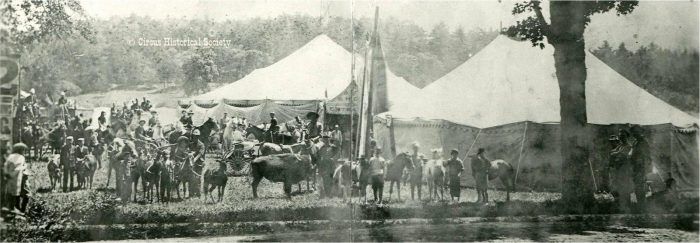
This year the Windjammers Summer Meet, as it has been occasionally in the past, is in Oskaloosa, IA near the C.L. Barnhouse Publishing Company, which is still, amazingly, printing sheet music for bands after 132 years. Barnhouse himself composed music used by circus bands as well as publishing it. Including “The Battle of Shiloh March.”
It’s too late to sign up for the meet this year, but if this music moves you, and you want to learn with experts how circus music was really played, consider joining.
It was Nancy Wyndham, wife of Tex Wyndham, the author of our Texas Shout column, who inspired this story by letting me know about the Windjammers. Upon seeing this post she sent the following extra information and gave me permission to add it to the story. Then after the mid-July event, she sent me a review of the experience. I’ve found some pictures and links to accompany the text to both letters.
Hi, Joe!
Tex considers “The Booster” to be the greatest syncopated march ever written. He calls it “‘The Stars And Stripes Forever’ of syncopated marches.” His favorite performance of it is on “Sounds Of TheCircus, Volume 4”, by The South Shore Concert Band, conducted by Richard Whitmarsh. Mr. Whitmarsh hit exactly the right tempo and, though the articulation in the trio isn’t quite as crisp as it could be, the performance really swings.
Mr. Whitmarsh was a Massachusetts-based retired schoolteacher who produced dozens of “Sounds Of The Circus” CDs (some of which are compilations of tracks from earlier issues arranged to illustrate a specific type of music, e.g., music for a grand entry, music for clowns, etc.). Tex has most of them.
We met Mr. Whitmarsh at the Worldwide Circus Summit in West Springfield, MA, in the summer of 2015. He had a booth where his CDs were being sold. He told Tex that he had recorded, and paid the musicians for, an additional six CDs, but lacked the funds to put the CDs on the market.
Mr. Whitmarsh was in his 90s at the time. He died at age 93 on March 19, 2017. He is in the Windjammers Hall Of Fame. His “Sounds Of The Circus” web site no longer exists, as far as we know. We assume the additional six CDs were never released. We have no idea whether the earlier ones are available anywhere for purchase.
We found out about the Worldwide Circus Summit by sheer coincidence. Tex had ordered six CDs from Mr. Whitmarsh, a couple of which were compilations. Mr. Whitmarsh very thoughtfully phoned Tex just to be sure Tex knew that the CDs contained previously released material. During the conversation, Mr. Whitmarsh happened to mention the Summit. We looked it up on the internet and immediately realized it was a “must-do”.
The event was four years in the planning. As you probably know, there are a number of organizations which have, as their main activity, some aspect of the circus. In addition to the Windjammers, who concentrate on circus music, there is a group of people who make model circuses, a group of people who own band organs, a clown group. an organization of circus owners (or, at least there was in 2015), groups of youths who learn acrobatic circus skills, etc. With circuses fading into the sunset, they decided to rent a huge fairgrounds in West Springfield and schedule their 2015 summer get-together for that weekend at that site, hiring the Cole Brothers circus to come and give three performances during the week.
“Fantastic” doesn’t begin to describe what took place. There were panels of experts in various fields, special interviews of prominent circus folks, special one-time-only performances by artists from different circuses interacting onstage, etc. The Windjammers fielded a 100-piece band for the Cole Brothers show that we saw. The Windjammers also did a special panel and had a smaller — about twenty pieces — group playing around the grounds from time to time. (Tex told me he got misty-eyed hearing, for his first time, “The Walking Frog” performed live.)
Your writeup includes a link to a performance from one of Mr. Whitmarsh’s “Sounds Of The Circus” CDs and also to a performance of “Miss Trombone” by Henry Fillmore. Fillmore wrote 15 “trombone smears” known as “The Trombone Family”. All of them are rags and are collected on Volume 54 of Mr. Whitmarsh’s “Sounds Of The Circus” CDs. The most frequently played one is probably “Lassus Trombone”, which has been recorded by a number of Dixieland bands.
Keep Swinging,
Nancy Wyndham
And another letter after the event.
Hi Joe, I think you would have loved attending Windjammers. 80 musicians were on hand, so we heard four days of great music played by an 80-piece circus band.
They would rehearse from Wednesday through Saturday in a local civic auditorium from 9 a.m. until about 10:15, take a break and then rehearse with a different conductor until lunchtime. After lunch, they would start at 2 p.m., play till about 3:15, take a break and play until 5 p.m. Every session had a different conductor. The tunes were scheduled in advance and none were repeated.
Wednesday evening was a rehearsal for the Friday evening show. Thursday evening was an outdoor concert in the park, played in a historic band kiosk, by the local community band, which put on a great show. Friday night’s concert was moved into a nearby shopping mall due to the threat of rain — probably a good thing, as the mall was air-conditioned and had good acoustics. The Friday show was performed by a sub-unit of the Windjammers, about 28 pieces, who were re-creating a local band led in the late 1800s by C.L.Barnhouse (of whom more later).
Again, they put on a terrific show. On Friday afternoon, instead of rehearsing, Andy Glover, vice-president of the C.L. Barnhouse publishing company, and the host person for the event, gave about an hour’s talk about the firm, which is one of the major publishers of band music in the country and which has been located in Oskaloosa. Iowa since the late 1880s, when cornetist/bandleader Barnhouse was hired to lead a local concert band and bought his publishing company along with him. Then we all went over to the Barnhouse facility, where Andy gave us a guided tour.
This was a fascinating afternoon. Everything the Windjammers played during the week was published by Barnhouse. Also, the Barnhouse firm owns Walking Frog Records, which specializes in band recordings. It is phasing out CDs, which no longer sell very well (this statement is true of all CDs, not just concert band CDs). It was selling the remaining stock for $10/CD. Tex bought six march CDs and, following up some leads, was able to order another six on the internet yesterday.
Saturday they rehearsed in the morning and then had a concert with the full band at 3 p.m. that afternoon in the civic auditorium. Once more, a sensational show. Then in the evening they gathered for a reception and banquet which we did not attend because we are not members of the Windjammers.
We were probably the only people who went to Oskaloosa just to listen to the music. There were only about 3-4 other people in the audience at the rehearsals; we believe they were all spouses or companions of the musicians. There was no charge to attend either the rehearsals or the evening concerts. Everyone was very welcoming to us. Next year’s meeting is in Pittsburgh, not so far away, and we might just go, knock around Pittsburgh for a few days and then listen to the circus music for several days. We’d join the Windjammers for that event because we are pretty sure, after our experience last week, that we wouldn’t be treated as outsiders.
Keep Swinging,
Nancy
Joe Bebco is the Associate Editor of The Syncopated Times and Webmaster of SyncopatedTimes.com






















